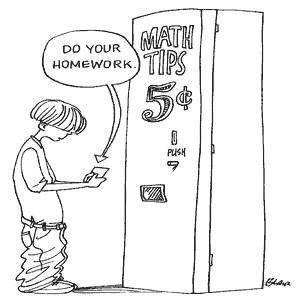| 1 |
W 1/16 |
Introduction, representing numbers, sign-value systems, Roman numerals, place-value systems, decimal numbers |
| 2 |
F 1/18 |
Positional number systems, decimal number system, binary number system, hexadecimal system, Mayan and Babylonian number systems |
|
M 1/21 |
NO CLASS |
| 3 |
W 1/23 |
Sets, elements, ∈, ∉, ellipses, union, ∪, intersection, ∩, subsets, ⊆ |
| 4 |
F 1/25 |
natural numbrs, integers, complements, set-builder notation |
| 5 |
M 1/28 |
Definitions, size of a set, cardinality, 1-to-1 matchings between sets, Cantor's definition of cardinality |
| 6 |
W 1/30 |
Cardinality, countable sets, integers and rationals are countable, the Grand Hilbert Hotel |
| 7 |
F 2/1 |
Introduction to mathematical arguments and logic: statements, negation, conjunction (and), disjunction (or) |
| 8 |
M 2/4 |
Quantifiers, proof by contradiction, √ 2 is not rational |
| 9 |
W 2/6 |
Uncountability of the real numbers, introduction to Number Theory |
| 10 |
F 2/8 |
Prime numbers, there are infinitely many primes, finding primes, Fermat primes, Mersenne primes |
| 11 |
M 2/11 |
Sieve of Erathostenes, Fundamental Theorem of Arithmetic, divisibility, Euclid's Lemma |
| 12 |
W 2/13 |
Gauss' formula, proof by induction |
| 13 |
F 2/15 |
Review |
| 14 |
M 2/18 |
FIRST MIDTERM EXAM |
|
|
| 15 |
W 2/20 |
SNOW DAY |
| 16 |
F 2/22 |
Induction; Introduction to graph theory, graphs, edges, vertices, degree of a vertex |
| 17 |
M 2/25 |
Degree Sum Formula, connected graphs, regular graphs, complete graphs, bipartite graphs, graph isomorphism |
| 18 |
W 2/27 |
Examples of isomorphic and nonisomorphic graphs, planar graphs and faces, Euler's formula for connected planar graphs |
| 19 |
F 3/1 |
Proof of Euler's formula, degree of a face, degree sum formula for faces |
|
|
SPRING BREAK |
| 20 |
M 3/11 |
Non-planarity of the complete graph on 5 vertices; polyhedral graphs, platonic solids |
| 21 |
W 3/13 |
Platonic solids, dual graphs and dual polyhedra, map colorings, greedy coloring algorithm |
| 22 |
F 3/15 |
every planar graph contains a vertex of degree at most 5; every planar graph is 6-colorable |
| 23 |
M 3/18 |
Euler cycles and Euler paths, criterion for Euler cycles |
| 24 |
W 3/20 |
Criterion for Euler paths, Fleury's algorithm, Eulerization, Hamiltonian cycles and paths |
| 25 |
F 3/22 |
Traveling salesman problem, weighted graphs, nearest neighbor algorithm, sorted edges algorithm |
| 26 |
M 3/25 |
minimal spanning trees, Kruskal's algorithm |
| 27 |
W 3/27 |
Review |
| 28 |
F 3/29 |
SECOND MIDTERM EXAM |
|
|
| 29 |
M 4/1 |
Introduction to cryptography, rules of modular arithmetic |
| 30 |
W 4/3 |
remainders, standard representation, divisibility by 9 |
| 31 |
F 4/5 |
modular exponentiation, Fermat's Little Theorem |
| 32 |
M 4/8 |
Examples of modular exponentiation, Diffie-Helman key exchange |
| 33 |
W 4/10 |
Public key cryptosystems, digital signature, random numbers |
| 34 |
F 4/12 |
Linear congruential generators, randomness testing, the game of set |
| 35 |
M 4/15 |
The birthday problem, Fibonacci numbers |
| 36 |
W 4/17 |
|
| 37 |
F 4/19 |
|
| 38 |
M 4/22 |
|
| 39 |
W 4/24 |
|
| 40 |
F 4/26 |
|
| 41 |
M 4/28 |
Review |
| 42 |
W 5/1 |
THIRD MIDTERM EXAM |
